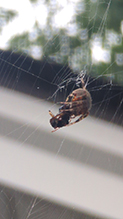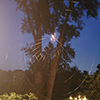Cross orbweaver
(Araneus diadematus)
Conservation • Description • Habitat • Biology • Distribution • Taxonomy
Conservation Status |
|
||||
| IUCN Red List | not listed |
||||
| NatureServe | not listed |
||||
| Minnesota | not listed |
||||
Description |
Cross orbweaver is an exotic, large, sedentary spider. It is native to Europe where it is extremely common. It was introduced into northeastern North America more than 140 years ago. The oldest North American record is from Newfoundland in 1881. In the United States it now occurs in the east from Maine to New Jersey, west to Minnesota and Illinois, and west of the Rocky Mountains from northern Washington to southern California. It occurs in southeastern Minnesota, where it reaches the western extent of its eastern range. Adults are found in late summer and fall in urban areas around buildings, in parks, and in gardens. They are often found in shrubs between houses. Females are ¼″ to ¾″ (6.5 to 20 mm) in length and have a ¾″ to 1½″ (20 to 40 mm) legspan. The overall color is variable, pale light yellowish-brown, brownish-orange, grayish-brown, or very dark brown. The following description is of the yellowish-brown color phase. The front part of the body (cephalothorax) is low, narrowed in front, and much smaller than the abdomen. The upper side (carapace) is uniformly yellowish-brown and is covered with shiny hairs. There is a brown or dark brown longitudinal stripe in the middle, and a dark irregular stripe near each lateral margin. The underside is dark brown. There are eight eyes arranged in two parallel rows of four eyes each. The rear row is curved forward, the front row is straight or slightly curved backward. All of the eyes are small, but the median eyes are larger than the lateral eyes. The abdomen is large, oval, rounded, and highest in front. There are two low rounded humps in the shoulder (humeral) area. The upper side is yellowish-brown and hairy. There is a pale, cross-shaped pattern of white spots toward the front. This is the feature that gives the spider its common name. Toward the rear there is a leaf-shaped mark (folium) with four pairs of large dark marks and several small white spots. On the underside of the abdomen there is a black longitudinal stripe in the middle and a pair of white spots near the rear. The legs are long, very spiny, and yellowish-brown, with distinct dark brown rings. The front two pairs project forward, the hind two pairs project backward. The last segment (tarsus) on each leg has three claws at the tip, though these are not visible to the naked eye. The male is smaller, ¼″ to ½″ (5.7 to 13 mm) in length. There are no humps on the abdomen and the folium is more distinct. The legs are darker and the banding is less distinct. The fifth leg segment (tibia) is stout and curved, and it has two rows of short, stout hairs (setae). |
Size |
Female Body Length: ¼″ to ¾″ (6.5 to 20 mm) Male Body Length: ¼″ to ½″ (5.7 to 13 mm) Legspan: ¾″ to 1½″ (20 to 40 mm) |
Web |
The web is large and oval. It is called an “orb”, which gives this family of spiders its common name. It is about 12″ (30 cm) in diameter and hangs slightly inclined from the vertical. There are usually about 30 radii. The center of the hub is closed. A retreat is sometimes constructed near the web in a rolled up leaf when available, otherwise it is made entirely of silk. |
Similar Species |
Habitat |
Urban areas around buildings, in parks, and in gardens |
Biology |
Season |
Late summer and fall |
Behavior |
|
Life Cycle |
The male matures earlier than the female. It chooses an immature female and stays close to her until she matures and they can mate. In Minnesota, eggs probably overwinter. In warmer climates, juveniles overwinter in bark crevices or in dead leaves. |
Food |
|
Distribution |
||
|
Sources |
|
| 8/10/2025 | ||
Occurrence |
||
|
||
Taxonomy |
|
Class |
|
Order |
|
Suborder |
Araneomorphae (Typical Spiders) |
Infraorder |
Entelegynae |
Superfamily |
Araneoidea (orbweavers and allies) |
Family |
|
Subfamily |
Araneinae (typical orbweavers) |
Genus |
Araneus (angulate and roundshouldered orbweavers) |
Subordinate Taxa |
|
|
|
Synonyms |
|
Aranea diadematus Araneus hortensis Epeira diademata Epeira hortensis |
|
Common Names |
|
cross orbweaver cross spider crowned orb weaver diadem spider European garden spider orangie |
|
Glossary
Carapace
The hard, upper (dorsal), shell-like covering (exoskeleton) of the body or at least the thorax of many arthropods and of turtles and tortoises. On crustaceans, it covers the cephalothorax. On spiders, the top of the cephalothorax made from a series of fused sclerites.
Cephalothorax
The front part of the body of various arthropods, composed of the head region and the thoracic area fused together. Eyes, legs, and antennae are attached to this part.
Folium
On some spiders, the leaf-shaped marking on the upper side of the abdomen.
Seta
A stiff, hair-like process on the outer surface of an organism. In Lepidoptera: A usually rigid bristle- or hair-like outgrowth used to sense touch. In mosses: The stalk supporting a spore-bearing capsule and supplying it with nutrients. Plural: setae.
Tarsus
On insects, the last two to five subdivisions of the leg, attached to the tibia; the foot. On spiders, the last segment of the leg. Plural: tarsi.
Tibia
The fourth segment of an insect leg, after the femur and before the tarsus (foot). The fifth segment of a spider leg or palp.
Visitor Photos |
Share your photo of this arachnid. |
||
This button not working for you? |
||
Jamie Smith |
 |
Mary S. |
 |
Kari Miller |
 |
Babette Kis |
||
 |
||
On web, St. Louis Park, Hennepin County, Minnesota.Photo taken August 3, 2022. |
|
|
 |
 |
|
Dorsal view on web, Garage at Barnes Prairie, Racine County, Wisconsin. Photo taken August 4, 2021. |
Ventral view on web, Garage at Barnes Prairie, Racine County, Wisconsin. Photo taken August 4, 2021. |
|
MinnesotaSeasons.com Photos |
|

Slideshows |
Cross Orbweaver (Araneus diadematus) |

Visitor Videos |
Share your video of this arachnid. |
||
This button not working for you? |
||
|
Other Videos |
Cross Orbweaver Araneus diadematus |
About
Oct 2, 2019 The Cross Orbweaver, Araneus diadematus, is one of the most commonly encountered spiders in the Northern United States, from coast to coast, and through Canada and Europe. More than any other spider in these areas, these are the most noticed and asked about as I identify spiders and insects for people on Instagram. It can be confused with the similar looking Neoscona crucifera which is sometimes called the barn spider, and that occurs in other parts of the United States. This particular female seems unhampered by her missing eighth leg. These spiders hatch in the spring or summer and by fall, when we are enjoying the last warm days of the year, and as Halloween approaches, they achieve their adult size and build massive orb webs. Males find females at this time, while females make the most of the tail end of bug season and store up nourishment to help them overwinter. In spring they will emerge from their recesses to deposit an egg sac. Upwards of a hundred baby spiders will emerge to repeat the life cycle, each one perfectly equipped to magically weave those perfect webs their mother's made. My channel here on YouTube will always be a mix of pet bugs and backyard bugs, along with the trips I take to see bugs strange to me. I hope you enjoy all the bugs I see along the way! |
The European garden spider Araneus diadematus in 4K |
About
Jul 18, 2020 *The spider species Araneus diadematus, is commonly called the European garden spider. Or, cross spider. It is an orb-weaver spider found in Europe and North America. Individual spiders' colorings can range from extremely light yellow to very dark grey, but all have mottled white markings across the dorsal abdomen, with four or more segments forming a cross. The markings are formed in cells filled with guanine, which is a byproduct of protein metabolism. Adult females range in length from 6.5 to 20 mm, while males range from 5.5 to 13 mm. Occasionally, the female will eat the male directly after mating. The legs of orb-weaver spiders are specialized for spinning orb webs. The webs are built by the larger females who hang head down in the center of the web or remain hidden in nearby foliage, with one claw hooked to a signal line connected to the main orb, waiting for a disturbance to signal the arrival of prey. Prey is then quickly bitten and wrapped in silk before being stored for later consumption. The initial bite serves to paralyze the prey, and minimize the danger of the spider herself, being stung or bitten. And the enzymes thus injected, serve to begin liquefaction of the prey's internal structures. Alongside the use of the web to capture other prey, the spiders are also cannibals and prey on each other. However, this only happens before, during, or after mating. A cross spider is a reclusive creature, and only bites humans if cornered or otherwise provoked. It responds to a disturbance by vibrating rapidly in its web until it becomes a blur, a reaction that is assumed to confuse potential predators. *The info was taken from Wikipedia. |

Visitor Sightings |
Report a sighting of this arachnid. |
||
This button not working for you? |
||
Jamie Smith |
Location: Fridley, MN |
 |
Mary S. |
Location: Ramsey, MN (Anoka County) |
 |
| Kari Miller 9/16/2024 |
Location: Austin, MN (Mower County) |
 |
Bridget Linette S. |
Location: Crookston, Polk County, Minnesota Found at night between two broken down cars feeding on a moth. Very large and yellow-orange in color. |
| Babette Kis 8/30/2022 |
Location: St. Louis Park, Hennepin County, Minnesota On web, St. Louis Park, Hennepin County, Minnesota.Photo taken August 3, 2022. |
 |
| Babette Kis 8/4/2021 |
Location: Barnes Prairie, Racine County, Wisconsin Dorsal view on web, Garage at Barnes Prairie, Racine County, Wisconsin. Photo taken August 4, 2021. |
 |
MinnesotaSeasons.com Sightings |
|

|
Created: 2/9/2023 Last Updated: © MinnesotaSeasons.com. All rights reserved. |
